
- Nineteenth Time
- Material
- Origine
- Period
- Sous-type
- A Aiguilles (16)
- Applique (7)
- Balancier (10)
- Bijou (8)
- Bougeoir, Chandelier (30)
- Bouteille, Flacon (7)
- Boîte (45)
- Cadre (28)
- Coffret (32)
- Console (7)
- Couteau (7)
- Encrier, Plumier (11)
- Figurine, Statue (18)
- Miniature (17)
- Mouvement Mécanique (15)
- Optique (10)
- Plateau (7)
- Reliquaire (7)
- Vase (45)
- Verseuse (6)
- Other (4041)
- Style
- Antique (17)
- Antiquity (10)
- Antiquité (21)
- Charles X (9)
- Directoire (8)
- Empire (22)
- Louis Philippe (43)
- Louis Xiii (9)
- Louis Xiv, Baroque (47)
- Louis Xv (19)
- Louis Xvi (144)
- Louis-philippe (16)
- Napoleon Iii (202)
- Napoleon, Empire (30)
- Napoléon Iii (233)
- Napoléon, Empire (72)
- Renaissance (54)
- Restauration (76)
- Restoration (40)
- Xixème Siècle (9)
- Other (3293)
- Type
- Applique (12)
- Armchair (18)
- Christianisme (33)
- Commode, Chiffonnier (11)
- Dessin (12)
- Drawing (14)
- Fauteuil (38)
- Frame Only (13)
- Huile (332)
- Lavis (21)
- Lithograph (11)
- Mural (25)
- Objet De Métier (22)
- Oil (101)
- Pendule à Poser (89)
- Plaque Décorative (174)
- Sculpture (51)
- Statue, Sculpture (52)
- Suspension, Lustre (12)
- Table (37)
- Other (3296)
1895 Parisian Life Bound Year Social Life Beautiful Era Fashion Customs
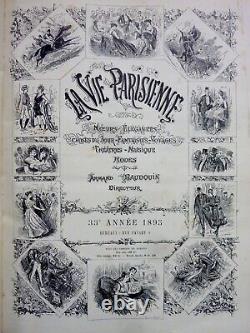

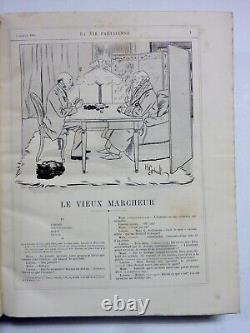
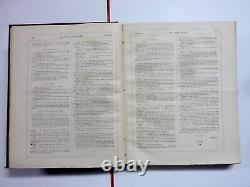
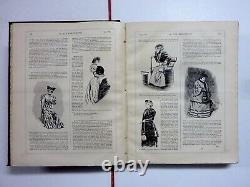
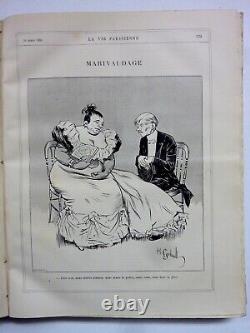
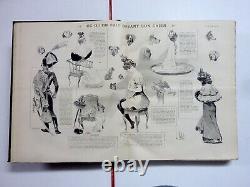
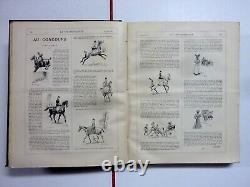
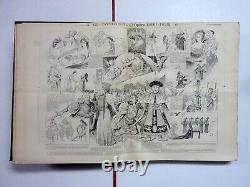
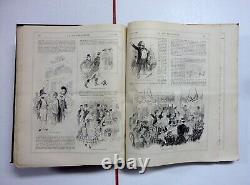

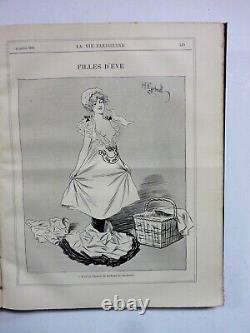
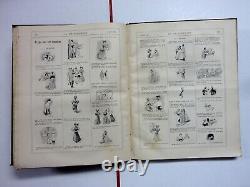
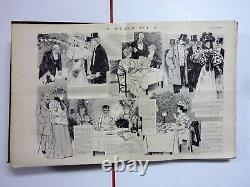
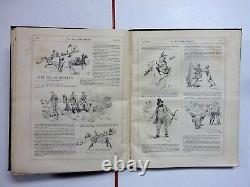
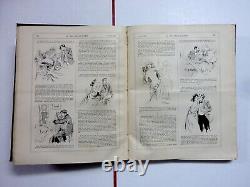

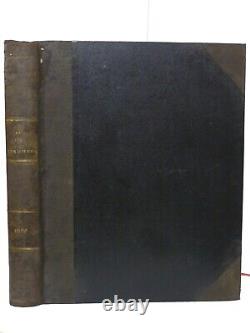
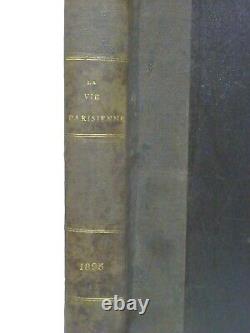


Things of the day - Fantasies - Travels. Complete bound year from the number of January 5 to the number of December 28. In a half-binding with black corners - cloth back and corners - cardboard covers - smooth spine with title and year in gold letters supported by gold fillets - marbled endpapers in color - format 28x35 - 759 pages - black illustrations (some erotic or of a curious nature). Regarding the binding, it is stated, "The title page of each issue must be removed during binding; the last page of each delivery will be bound on a tab. The table of contents will be placed at the end of the volume.
" Old magazines, culture, high society, press, the Belle Époque. The overall condition is correct to good, beginning of "loosening" of the connections with the covers, some binding marks, faded spine, some foxing depending on the pages, solid.
Complete bound year; an ex-libris; heavy (nearly 4kg without packaging). OTHER COMPLETE YEARS OF THE MAGAZINE IN THE SAME BINDING WILL BE OFFERED ON THE SITE. 1884 - 1886 - 1887 - 1888 - 1889.
1890 - 1891 - 1892 - 1893 - 1894 - 1895 - 1896. DO NOT HESITATE TO CONTACT ME IF NEEDED. La Vie parisienne is a French illustrated cultural magazine created in 1863 by Marcelin and published without interruption until 1970. It gave its name to the famous opéra-bouffe by Jacques Offenbach, La Vie parisienne. Developing a unique literary and critical approach until 1905, it soon turned towards a more male audience, making room for erotic illustrations. Not directly related, a magazine revived this name in 1984 targeting a "discerning audience." The expression "vie parisienne" entered common use during the Restoration and gained significant popularity when Balzac published, as early as 1834, a collection of novels titled Scènes de la vie parisienne, which made up a large part of his love stories grouped under the generic title of La Comédie humaine. However, it was during the Second Empire that Paris became a reference in cultural life, especially regarding fashion and social events. Taking advantage of a relatively relaxed freedom of expression felt in the middle of the Second Empire, Émile Marcelin envisioned launching a magazine titled La Vie parisienne at the end of 1862 in Paris, subtitled "Elegant Loves, Things of the Day, Fantasies, Travels, Theaters, Music, Fashion": it was an illustrated weekly that aimed from January 1863 to show the joys and pleasures of high society in the capital and, notably, its theatrical life. In love with an actress, a costume designer in his spare time, Marcelin initially drew most of the images, then welcomed writers and illustrators, not without facing some outraged criticism in response to the gossip reported and his risqué boldness, which sometimes involved sketching the legs of an actress or referencing demi-mondaines. In its theatrical critiques, the magazine employed a vivid and straightforward style. The targeted audience was clearly the bourgeois couple in search of evenings, leisure, entertainment, fond of the stage, balls, chansonniers, and the latest fashion, undoubtedly weary of rigid reports and amused by caricatures.It should be noted that La Vie parisienne contributed to both the liberalization and diversification of the press; that same year, Le Petit Journal, an evening daily, also emerged, quickly opposing what was considered too serious journalism. La Vie parisienne also offered short stories and dialogued tales aimed at an impatient reader.
As early as June 1866, Jules Barbey d'Aurevilly highlighted the originality of the content, commenting on Gustave Droz: "But after all, if this newspaper does not exactly represent all of Parisian life, it does represent a part. It captures the froth, the sparkle, the surface, the little vices - viciolets - the elegances, and the elegances up to the extravagances, all very animated with spirit, very sharp with irony, very indifferent - and even too much - to morality, and I would almost say to literature; for the talented men who make this newspaper have the dandyism of not appearing literary.
" The columnists signed with initials or fanciful pseudonyms that referred readers to the "indiscretions" of a certain milieu, the high society or aristocracy, anticipating what today would be called "celebrity" press. Until 1914, La Vie parisienne influenced the evolution of theater and cultural mores in its own way: in 1889, the Théâtre Antoine staged a play adapted from the stories and tales published in the magazine. The style soon became a school, especially since Offenbach's opéra-bouffe had experienced enormous success, with librettists Ludovic Halévy and Henri Meilhac having written for the magazine in its early days. The headquarters was once located at 9 Place de la Bourse. In 1905, the title was purchased from Armand Baudouin by Charles Saglio, a member of the Petit Journal editorial team, who, taking advantage of a relaxation of censorship, opened La Vie parisienne to erotic illustrations, which would later cause him some trouble.
In April 1907, Colette published her first short story there. During World War I, it was read in the trenches and published requests (and offers) for "war godmothers," a feminine figure that regularly illustrated the cover - another illustrated weekly, La Baïonnette, did the same.
In the 1920s, cinema began to hold an important place in it, and the first black and white photographs of women in nightgowns appeared in the 1930s. Towards the end of the 1940s, the title was taken over by Georges Ventillard, and color photography made its appearance, favoring increasingly nude pin-ups.

